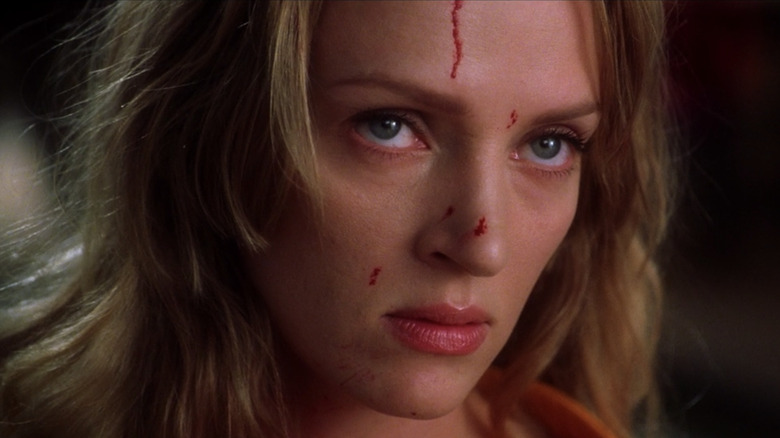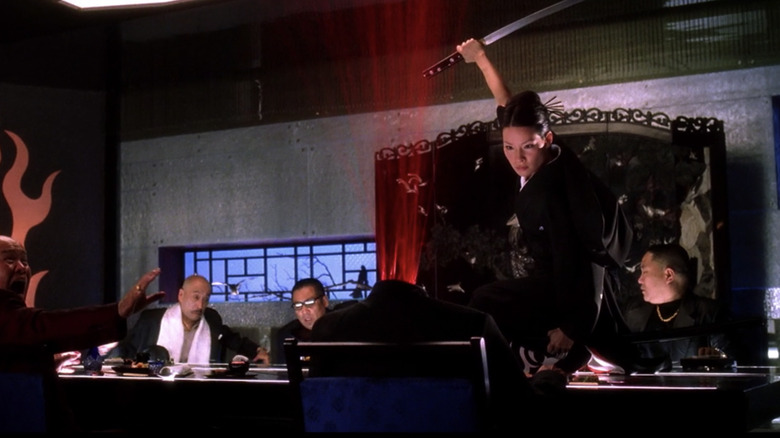Quentin Tarantino Only Wanted The Best Blood For Kill Bill's Special Effects
The rise of digital effects has dramatically shifted how movies of all budget sizes get made. While a lot of the work effects artists have done is absolutely phenomenal, there are two areas where their limitations are most prevalent. The first is obviously in digitally recreating human faces. Whether it is the de-aging we see so much of now or just entirely creating someone's face from scratch, there is always something off about the end result. A person's face contains so much nuance that the ones and zeroes of a computer just haven't been able to process yet. There have been improvements since the days of the frightening "The Polar Express," where the people look like weird lifeless dolls shuffling around, but you can still always clock a fake face.
The other is blood. Liquid in general has been tough to replicate digitally, but something about the consistency and weight of blood has really tripped up a lot of action and horror films. There have been well-shot and choreographed action scenes ruined by the use of digital blood. When you don't have the right blood in the scene, the dangerous, visceral nature of the moment gets completely washed away. Luckily, one director today still understands the benefit of using practical fake blood on set, and unsurprisingly, it is Quentin Tarantino, creator of some of the bloodiest scenes of the last thirty years and the poster boy for old-school movie-making. This is no more apparent than in what is possibly the filmmaker's bloodiest film, "Kill Bill." Not only did Tarantino need gallons upon gallons of fake blood to achieve the right level of violence for his revenge tale, but he also needed it to look exactly right in order to properly convey the era of films he was paying homage to.
Samurai blood, not horror movie blood
As per usual with Tarantino, "Kill Bill" is one giant amalgam of references that he cobbled together to create something completely his own. This film was a giant, two-part spectacular, so the references were even more wide-ranging than ever. "Volume 1" took its cues from Hong Kong and Japanese cinema of the 1970s, from "Lady Snowblood" to the films produced by the Shaw Brothers, and "Volume 2" was the first time he really got to play with his love of the Western. But "Volume 1" is really where all the blood is, particularly in the massive showdown between Uma Thurman's Bride and the Crazy 88s gang. For the blood in this film, Tarantino needed it to look like the same blood created 30 years earlier. He said to Time:
"I'm really particular about the blood, so we're using a mixture depending on the scenes. I say, 'I don't want horror movie blood, all right? I want Samurai blood.' You can't pour this raspberry pancake syrup on a sword and have it look good. You have to have this special kind of blood that you only see in Samurai movies."
He needed this to be done "the Chinese way," which only makes sense if those are the films you are harkening back to. Most of the fake blood made by effects people in Hollywood tends to be fairly dark and thick, attempting at a kind of realism. "Kill Bill" wasn't going for realism in the slightest. This blood is bright red and thinner. It deliberately looks unreal to be used as a stylistic garnish rather than replicating the true consequences of violence.
Tarantino knows strides have been made in digital blood. He goes on to say, "That s*** looks good, but it looks like a computer did it ... I'd rather have it look good and look like a cool '70s thing." Digital blood would have made "Kill Bill" feel like it was missing authenticity. Now, plenty of violent films made in Hong Kong and Japan use digital blood that are trying to homage this same era of films, but there is still some distancing that occurs when a spray of virtual blood hits a wall. There's very little impact, and because the blood isn't there on set, no one is reacting to how giant splatters of red liquid everywhere. You throw on "Kill Bill" today, and you will still be blown away by every single blood effect in the film because of how it completely changes the atmosphere of the scene whenever people get completely covered in it, which is quite frequent.

